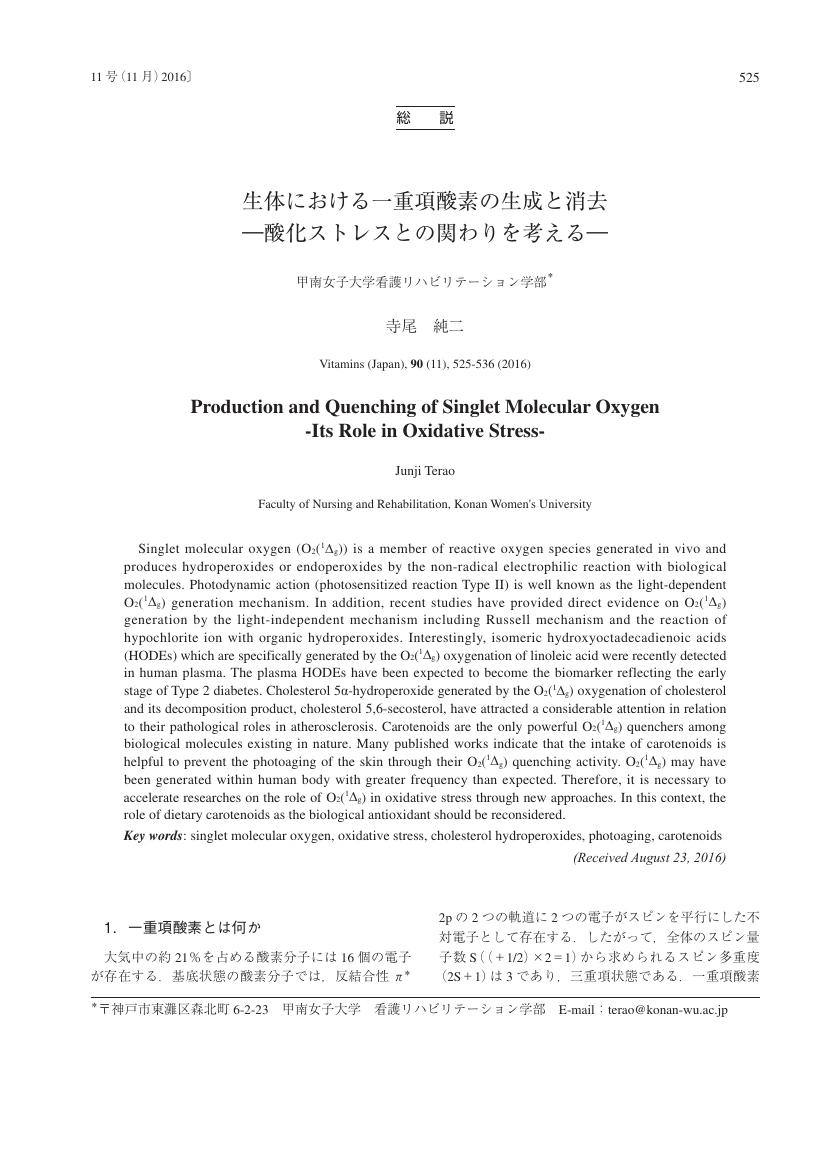1 0 0 0 『十五小豪傑』から『海外天』へ
- 著者
- 陳 愛陽
- 出版者
- 武蔵野短期大学
- 雑誌
- 武蔵野短期大学研究紀要 = The bulletin of Musashino Junior College (ISSN:02888025)
- 巻号頁・発行日
- vol.29, pp.421-425, 2015
1 0 0 0 中国共産党情報組織発展史 (特集 インテリジェンス文化)
- 著者
- 岩谷 將
- 出版者
- 情報史研究会
- 雑誌
- 情報史研究 (ISSN:18838685)
- 巻号頁・発行日
- no.5, pp.75-84, 2013-09
1 0 0 0 OA 人体ファントム線量測定に基づいた各種頭部X線検査における患者の臓器線量及び実効線量評価
- 著者
- 川浦 稚代 青山 隆彦 小山 修司
- 出版者
- 公益社団法人 日本アイソトープ協会
- 雑誌
- RADIOISOTOPES (ISSN:00338303)
- 巻号頁・発行日
- vol.54, no.3, pp.55-66, 2005-03-15 (Released:2011-03-01)
- 参考文献数
- 17
- 被引用文献数
- 3 3
蛍光ガラス線量計とフォトダイオード線量計を設置した人体ファントム線量計測システムを用いて, 頭部一般撮影検査及び頭部X線CT検査における患者の臓器及び実効線量評価を行った。5種類の頭部一般撮影検査における脳線量は, 0.46~1.08mGyであった。水晶体線量は, 水晶体に直接X線が当たるような頭部正面 (AP) 及びタウン撮影法において最も高かった。また, 頭部一般撮影検査における実効線量は, 0.03~0.06mSvであった。一方, 頭部X線CT検査 (ルーチン検査) における実効線量は, 1.7mSvであり, 頭部正面 (AP) 検査よりも50倍以上高いことがわかった。急性脳梗塞の診断に用いられるPerfusion検査においては, 最大皮膚線量が712.0mGyとなった。しかしながら, その値は, ICRP Publ.59で提唱されている一時脱毛のしきい値3Gyよりも低かった。また, 頭部X線CT検査における水晶体線量 (ルーチン検査: 55.0mGy, Perfusion検査: 39.6mGy) は, ICRP Publ.60で提唱されている検知可能な水晶体白濁のしきい値0.5~2.0Gyよりも低い値を示した。
1 0 0 0 OA 堆積シーケンスとその境界の認定と意義
- 著者
- 安藤 寿男
- 出版者
- Tokyo Geographical Society
- 雑誌
- 地学雑誌 (ISSN:0022135X)
- 巻号頁・発行日
- vol.99, no.3, pp.247-262, 1990-06-25 (Released:2009-11-12)
- 参考文献数
- 49
- 被引用文献数
- 1
The depositional sequence concept was established in newly developed sequence stratigraphy, as an unconformity-bounded stratigraphic unit formed during one complete sea-level cycle. This paper reviews general meanings of “sequence”, the definition of depositional sequences, their hierarchial patterns and recognition, and sequence boundaries problems, from a viewpoint of sedimentary geology based on outcrops and bore-hole samples.Though the word, “sequence” has many meanings generally applied to successive geologic events and processes in chronologic order, a depositional sequence is defined in a special sense, as “a relatively conformable succession of genetically related strata bounded at its top and base by unconformities and their correlative conformities”. The depositional sequence as one of hierarchial transgressive and regressive units (T-R units), has the first- to forth-order operational units, that is, the megasequence, supersequence, sequence and parasequence in descending order. A sequence boundary with a significant hiatus (=unconformity) is formed by subaerial exposure, concurrent subaerial erosion and partly submarine erosion during eustatic falls or low-stand sea level.The latter half of this paper emphasizes the difference between sequence boundaries and ravinement surfaces. The ravinement surface formed as one of diastems or “transgressive surfaces”, is an erosional surface by shoreface retreat during the following transgression after a sea-level fall. In general, it is lithologically more distinct than the underlying sequence boundary. The right recognition of the difference leads correct reconstructions of sedimentary history.
1 0 0 0 OA 満足できる人生の幕引きのために-根拠に基づく医療介護整備への学際的実証研究
- 著者
- 田宮 菜奈子 森山 葉子 山岡 祐衣 本澤 巳代子 高橋 秀人 阿部 智一 泉田 信行 Moody Sandra Y. 宮田 澄子 鈴木 敦子 Mayers Thomas Sandoval Felipe 伊藤 智子 関根 龍一 Medeiros Kate de 金 雪瑩 柏木 聖代 大河内 二郎 川村 顕 植嶋 大晃 野口 晴子 永田 功 内田 雅俊 Gallagher Joshua 小竹 理奈 谷口 雄大
- 出版者
- 筑波大学
- 雑誌
- 基盤研究(B)
- 巻号頁・発行日
- 2014-07-18
誰もが満足できる人生の幕引きができるシステム作りのための、介護医療における実証研究およびそれに基づく提言を目的とした。まず、内外のガイドライン等レビューを行い、次に、我が国における医療・介護における実態・分析として、①看取り医療の実態と予後の検証(医療の視点)を救急病院での実態やレセプト分析により、②老人保健施設における看取りの実態(介護の視点)を、介護老人保健施設における調査から実施した。実態把握から根拠を蓄積し、本人の納得のいく決定を家族を含めて支援し、その後は、適切な医療は追求しつつも生活の質を一義としたケアのあり方を議論し、工夫実行していくことが重要であると考える。
1 0 0 0 OA 中央アジア、シルクロード拠点都市と地域社会の発展過程に関する考古学的研究
本研究の目的は、シルクロードの交易拠点都市の成立と展開の実態を明らかにすることである。そのために、中央アジアのキルギス共和国北部に位置するアク・ベシム(スイヤブ)遺跡において発掘調査を実施し、考古学的な研究を行った。発掘調査によって都市のプランや構造を明らかにするとともに、周辺地域の調査によって、都市の成立と繁栄に不可欠な水利システムの存在を解明することができた。こうした成果によって、シルクロード沿いの拠点となる交易都市の成立と展開、そして同都市が位置する地域の発展過程について考察することができた。
1 0 0 0 IR 『ロビンソン・クルーソー』における倫理と宗教
- 著者
- 岩佐 満雄
- 出版者
- 大阪教育大学発達人間学講座
- 雑誌
- 発達人間学論叢 (ISSN:1349628X)
- 巻号頁・発行日
- no.2, pp.71-84, 1998
『ロビンソン・クル-ソー』をめぐる解釈には様々なものがあるが、その一つに敬虔なピューリタニズムの形象、資本主義の精神を先取するものとして捉えるものがある。本論では、ロビンソン・クルーソーとして描かれた人物の信仰の問題を考察することによって、従来の解釈の一面性を指摘した。また、ロビンソンが、信仰を互酬的応報的に捉えている側面や誠実に思索を重ねている側面に論及した。さらに、改宗の問題を通じて、信仰の非敬虔的側面、改宗における暴力の問題を考察し、他者危害の問題を提示した。最後の生命尊重の問題において、生命それ自体の尊重ということよりも、相手からの危害の有無が重要な論点となっていることを考察した。
1 0 0 0 OA ヘモグロビンにおけるサブユニット間相互作用
- 著者
- 今井 清博
- 出版者
- 一般社団法人 日本生物物理学会
- 雑誌
- 生物物理 (ISSN:05824052)
- 巻号頁・発行日
- vol.12, no.3, pp.114-129, 1972-05-25 (Released:2009-05-25)
- 参考文献数
- 78
- 著者
- 河野 美奈子
- 出版者
- RIKKYO UNIVERSITY (立教大学)
- 巻号頁・発行日
- 2016-09-19
1 0 0 0 OA 明治43年京都の洋楽事情 : ある商家の若妻の日記を基に
- 著者
- 塩津洋子
- 出版者
- 大阪音楽大学
- 雑誌
- 音楽研究 : 大阪音楽大学音楽博物館年報 (ISSN:21867690)
- 巻号頁・発行日
- vol.24, 2009-05
1 0 0 0 OA 咄の絵有多 : 古今青楼
1 0 0 0 IR 児童相談所一時保護所の援助体制と職員の実態に関する調査研究
- 著者
- 村田 一昭
- 出版者
- 愛知県立大学
- 雑誌
- 社会福祉研究 (ISSN:13457179)
- 巻号頁・発行日
- vol.12, pp.41-50, 2010-07
1 0 0 0 児童養護施設職員の職場環境とストレスに関する研究
- 著者
- 伊藤 嘉余子
- 出版者
- 一般社団法人 日本社会福祉学会
- 雑誌
- 社会福祉学 (ISSN:09110232)
- 巻号頁・発行日
- vol.43, no.2, pp.70-81, 2003
本研究では,「子どもへの援助の質的向上」という視点から,施設職員の職場環境を検証することを目的として,全国554か所の児童養護施設の児童指導員と保育士を対象に,施設の職場環境の実態と職員のストレス認知および対処方法,職場環境改善への要望に関する意識調査を実施した。その結果,職員が施設で働くなかで感じる過度の不満や負担感,ストレスとそれに対する対処方法,ストレスを感じないために講じている予防策について明らかになった。調査結果を踏まえて,今後,施設職員のストレスを軽減し,職員が子どもに対して常に適切なケアを提供していくために必要な職場環境の改善点として,(1)施設職員の労働条件の改善,(2)施設内スーパービジョン体制の充実,が挙げられた。
- 著者
- 筒井 孝子 大夛賀 政昭 東野 定律 山縣 文治
- 出版者
- 一般社団法人 日本社会福祉学会
- 雑誌
- 社会福祉学 (ISSN:09110232)
- 巻号頁・発行日
- vol.53, no.1, pp.29-40, 2012
本研究の目的は,児童自立支援施設において小規模ケアおよび家庭的養育を具現化してきた小舎夫婦制と交代制によって提供されたケアの内容および時間,ケアに関わる職員の負担感に関する実証的データを比較し,これらのケア提供体制の特徴を明らかにすることである.その方法として,児童自立支援施設2施設において,他計式1分間タイムスタディ調査データを用いての分析を行った.研究の結果,小舎夫婦制の入所児童の情緒・行動上の障害の程度は,交代制より比較的重く,また,提供されたケア内容は身の回りの世話に関するケア時間が長かった.さらに,小舎夫婦制での提供時間は交代制よりも長かったが,交代制に比較すると負担感は軽かった.今後は,すでに運営が困難となっている小舎夫婦制に変わる新たな体制を模索するとともに,すでに実施されている交代制においても人事マネジメント等のあり方を改めて検討する必要があると考えられた.
- 著者
- 趙 正祐
- 出版者
- 一般社団法人 日本社会福祉学会
- 雑誌
- 社会福祉学 (ISSN:09110232)
- 巻号頁・発行日
- vol.55, no.1, pp.76-88, 2014
本研究の目的は,児童養護施設における被虐待児の増加の現状を踏まえ,共感満足/疲労という概念を取り入れて援助者の共感満足/疲労が子どもとの関わり方にどう影響するかを明らかにし,援助者支援のあり方について提言することである.調査は自記式質問紙で児童養護施設の職員を対象に14ヵ所の職員266人中,149人の回答を得て分析に用いた.その結果,「満足L疲労H」群は,子どもへの否定的関わりの可能性が示されて「満足H疲労H」群は,肯定・否定的関わりが両方高い傾向が見られ,二重的関わりの特徴が示唆された.「満足L疲労L」群は,肯定・否定的関わりは低い傾向が見られたが,バーンアウトリスクは高く見られた.このように,共感満足/疲労の度合いにより,子どもに否定・肯定的影響があることが明らかになった.そのため,援助者支援には,個人特性を踏まえた多様な職員集団を支援するための研修やスーパービジョンの必要性が示唆された.
- 著者
- 細井 香 Kaori HOSOI
- 出版者
- 淑徳短期大学紀要委員会
- 雑誌
- 淑徳短期大学研究紀要 (ISSN:02886758)
- 巻号頁・発行日
- no.49, pp.67-81, 2010
首都圏の保育・介護等の専攻コースを持つ女子短期大学の卒業生5000名を対象に「福祉(保育・介護)労働に関する調査」を実施した。回収された718名(回収率14.4%)のうち、現在、福祉労働に従事している288名の回答を分析した。本分析は、調査項目のなかから、「保育労働者の健康についての実態把握と、労働環境および関連要因との検討」を行うことを目的として行われている。分析の結果、保育労働者の約3割が健康状態を悪いと評価しており、自覚症状として「肩こり」、「腰痛」、「首のこり」などの症状を多くの者が訴えていた。また、健康状態の評価には、「ストレスの度合い」「身体の疲れ度合い」「仕事のやる気度」が影響を及ぼしていることが明らかとなった。
1 0 0 0 OA 生体における一重項酸素の生成と消去―酸化ストレスとの関わりを考える―
- 著者
- 寺尾 純二
- 出版者
- 公益社団法人 日本ビタミン学会
- 雑誌
- ビタミン (ISSN:0006386X)
- 巻号頁・発行日
- vol.90, no.11, pp.525-536, 2016 (Released:2017-12-26)
1 0 0 0 OA 人型ロボットを用いた講義動画配信システム「SUPICE」の開発
- 著者
- 永田正樹 磯部千裕 李芷君 山崎國弘 長谷川孝博 井上春樹
- 出版者
- 国立大学法人 情報系センター協議会
- 雑誌
- 学術情報処理研究 (ISSN:13432915)
- 巻号頁・発行日
- vol.21, no.1, pp.3-12, 2017-09-25 (Released:2018-08-03)
- 参考文献数
- 20
人型ロボットを用いた講義動画を広域配信するシステム「SUPICE」を開発した.近年,日本の少子化に起因する大学のグローバル化に伴い,遠隔での学習が可能な反転授業が注目されている.反転授業では動画教材を用いるため,正確な反復性および多言語発話などが可能な人型ロボットでの動画作成が適している.そこで我々は,(1)利用者からパワーポイントスライドを受領し,(2)受領スライドに基づく多言語講義を人型ロボットが実演し,(3)実演した様子を動画化し,(4)その動画をインターネット上にて広域配信する講義動画配信システム「SUPICE」を開発した.「SUPICE」を用いることで,1体の人型ロボットにて複数の講義を同時に実施でき,かつ受講者はインターネット経由でいつでも講義動画を受講できるようになった.静岡大学学内での講義や説明会にて「SUPICE」の検証を実施し,本システムの有効性を確認したため,2017年4月から全学向けサービスを開始した.

